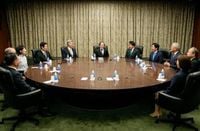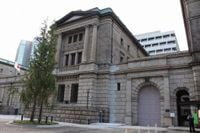The Bank of Japan (BOJ) announced on May 1, 2025, its decision to maintain the policy interest rate at the current level of around 0.5%. This marks the second consecutive meeting where the interest rate has remained unchanged since the hike in January 2025. The decision reflects a cautious approach by the BOJ as it assesses the impact of the Trump administration's tariff policies on the real economy.
During the monetary policy meeting, the BOJ also released its latest "Outlook for Economic and Price Developments" report, which included significant revisions to the forecasts for real GDP growth and consumer price inflation for fiscal years 2025 and 2026. The outlook for real GDP growth was revised downward from an earlier estimate of 1.1% to 0.5% for fiscal year 2025, and from 1.0% to 0.7% for fiscal year 2026.
Governor Kazuo Ueda, who will hold a press conference later today to explain the decision, indicated that the BOJ continues to prioritize monitoring the effects of tariff negotiations between the U.S. and Japan, as well as trends in the financial markets. Ueda stated, "We must carefully assess the impact of the U.S. tariff policies on Japan's economy and prices before making any further changes to our monetary policy." This sentiment reflects a broader concern within the BOJ about the uncertainties posed by the U.S. tariffs, particularly on the manufacturing sector.
The BOJ's report also noted that the target for achieving the "price stability target" of a 2% increase in prices compared to the previous fiscal year has been postponed to fiscal year 2027. Previously, it was expected to be achieved in the latter half of fiscal year 2025 or during fiscal year 2026. This delay highlights the challenges the BOJ faces in stabilizing inflation amidst external economic pressures.
In terms of consumer price inflation, the forecast for the rate of increase in the Consumer Price Index (CPI), excluding fresh food, was adjusted downwards as well. The BOJ now projects a 2.2% increase for fiscal year 2025, down from the previous estimate of 2.4%, and a 1.7% increase for fiscal year 2026, down from 2.0%. This adjustment is indicative of the anticipated negative effects of the U.S. tariffs on Japan's export performance and overall economic activity.
As the BOJ navigates these economic challenges, it remains committed to its long-term goal of achieving stable inflation. Ueda emphasized that, "If the underlying inflation rate, excluding temporary fluctuations, is projected to rise towards 2%, we will adjust our interest rates accordingly." However, the pace of any future rate hikes may be slower than previously expected due to the ongoing uncertainties stemming from the U.S. tariff policies.
The impact of the U.S. tariffs is particularly concerning for Japan's automotive and steel industries, which are expected to face downward pressure on their business performance. The BOJ has voiced that the uncertainties in the global economy make it difficult to predict the timing of future interest rate increases. Ryuutarou Kono, chief economist at BNP Paribas Securities, noted, "Predicting the next interest rate hike is challenging. Currently, we expect it to occur between January and March of 2026, but if the global economic slowdown is less severe than anticipated, it could happen sooner, possibly within 2025."
In light of these developments, the Japanese government is also engaged in ongoing tariff negotiations with the U.S. Economic and Fiscal Policy Minister Akira Amari is scheduled to hold a second round of discussions with U.S. officials today. The outcomes of these negotiations will be critical in shaping Japan's economic landscape moving forward.
The BOJ's decision to maintain the interest rate comes amid a backdrop of global economic uncertainty, with many analysts concerned about the potential repercussions of the U.S. tariff measures on Japan's economic recovery. As the situation evolves, the BOJ's cautious approach and commitment to monitoring economic indicators will be crucial in determining the future trajectory of Japan's monetary policy.
Overall, the BOJ's latest policy decision underscores the delicate balance it must strike between fostering economic growth and ensuring price stability in an increasingly complex global economic environment. With the potential for external shocks from U.S. trade policies, the BOJ is poised to remain vigilant in its assessment of the economic landscape.





